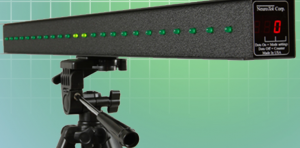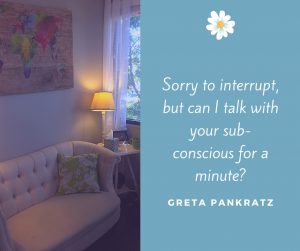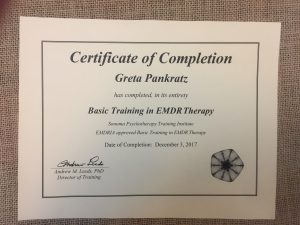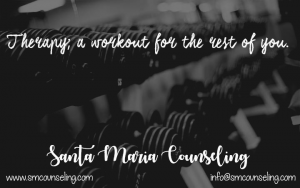I am writing this blog primarily for my wonderful patients. I need there to be a quick and readable source to help them become educated on EMDR. I will cover a couple topics regarding EDMR including:
What is it?
Who might benefit from it?
Why might EMDR be worth trying?
What if I am scared it won’t work for me or that I won’t be able to do it right?
How do I know Greta really knows what she’s doing when it comes to EMDR?
Will it hurt?
Where can I learn more?
What is it?

EMDR is an acronym used to describe a psychotherapy technique called Eye Movement Desensitization and Reprocessing. Although research has not discovered exactly how EMDR works, we have research saying it does. Every quarter, Andrew Leeds, PhD. writes up a bibliography for the EMDR International Association of the latest research on EMDR–in March 2019 alone there were at least a dozen new studies proven its effectiveness for a range of conditions. I think EMDR falls under a lot of scrutiny from the skeptics (like anything worthwhile, it has its fair share of skeptics) because truly, we don’t know why most psychotherapy techniques work. There are 8 phases to EMDR treatment. The phases that get the most attention is phases 3-6–when your therapist uses Bilateral Stimulation (BLS) while you focus on a disturbing memory, thought, emotion or body sensation. BLS can be anything that activates alternating sides of the brain. In my office, I have a light bar, tappers and auditory tools. Patients either use their eyes to follow the lights as they move across the bar, hold in their palms the tappers that provide alternating vibrations or listen to alternating tones through headphones. The first two phases provide the patient with the tools to learn to live most of their days in their window of tolerance which will help their brain reprocess more effectively during phases 3-8. The final phases ensure that the disturbing memory is now associated with positive thoughts, body sensations and emotions. Keep the memory, but change the effects it has on your day to day life. Need an example? Me too, I love examples.
So, lets pretend you grew up in a home with two busy parents. They were loving, consistent and protective, but you just didn’t feel heard emotionally. You didn’t feel seen, known and attuned to. Now as an adult, you tend to ignore your own needs, run yourself ragged or choose maladaptive means to sooth yourself (food, drinking, TV, gaming etc.) You may have an underlying belief that “I don’t matter” or “I’m not valuable” or “I don’t deserve love”. EMDR can help to unhook this negative belief from those early childhood experiences. A successful reprocessing of this target would result in you being able to think about yourself as a child, ignored and feel/believe, in your gut, that you have value, your needs matter and you deserve love. Many of us know these things are true (head knowledge) but we struggle daily to believe them in our hearts. This is what EMDR does, it moves head knowledge into the heart, body and soul; so living out of this belief is automatic. Most people report that things that were hard to do or took a lot of mental energy to do are now natural and automatic.
Who Might Benefit from EMDR?
EMDR was originally developed to treat PTSD–Post-traumatic Stress Disorder. We now know that EMDR can be used a range of disorders from PTSD to eating disorders. There are many different protocols for the various diagnosis that can be treated. I am not trained in all of those protocols…yet! I use EMDR and its wide array of tools for almost every patient. Although BLS might not be indicated for every patient, phases 1 and 2 can be. Those phases in EMDR include techniques that stabilize mental decline of almost any kind.
Why Might EMDR be Worth Trying?
If talk therapy hasn’t worked, EMDR may be able to reach parts of your subconscious that just talking can’t. If you struggle to connect to your emotions, EMDR might help bring those to the surface. If areas of your life feel stuck or unresolved, EMDR might help to move you forward.

I’ve been practicing therapy on some level since 2000 and have been trained and tried many different techniques. By far, the most effective is EMDR.
In addition, although EMDR is certainly hard psychological work, I find its the least painful way to resolve trauma. EMDR can even be successful on “blind” targets, meaning, you can decide in your mind what you want to work on without having to go over the details of it with your therapist. This makes EMDR far less upsetting than Exposure Therapy or even Cognitive-Behavioral Therapy. There are some EMDR protocols that actually work best if you only briefly “flash” on the incident mentally, but ultimately think of something positive. We have many other distancing techniques in EMDR to help lessen the distress felt during the work.
What if I am Scared?

Good news, you can’t do EMDR wrong. Some people are not good candidates for EMDR, but that is not because you failed, its because EMDR is limited, or maybe your therapist hasn’t been trained in the right protocol for you. Remember, you are a collaborator with your treatment provider. They are experts and should have a better idea than you what the path to healing is, they rely on your expertise on you to make good decisions at those forks in the road. One phrase I keep in mind while I am working with someone is “we can only go as fast as the slowest part of our patient”. Meaning, if there is a part of you that is scared, let’s listen to that part and help it to feel safe before moving forward. EMDR can even be used to lower the fear you have about EMDR!
How can I Trust Greta?
I received an excellent EMDR training from the Sonoma Psychotherapy Training Institute (PTI) with Andrew Leeds, PhD. Most EMDR training are done over two 3-day weekends (all the EMDR training offered in Santa Barbara and San Luis Obispo Counties are on this schedule I believe). I knew that this schedule was not conducive to deep learning for me. Also, most trainings require you to get your own consultation in between training, which may or may not match up with your training. Sonoma PTI spreads their training out over four 2-day weekends (in San Jose) and includes consultation with the training. This gives you less information to digest, a month to practice and consultation that matches perfectly with the training. Andrew Leeds wrote “A Guide to the Standard EMDR Protocols for Clinicians, Supervisors and Consultants”. He trains all over the world for the EMDR International Association. Dr. Leeds know what he is talking about. In other words, not all EMDR trainers and training are created equal, I believe I received a high quality EMDR training.
Although I have only been EMDR trained since 2017, I worked hard that year after to gain 20 hours of consultation and additional training, while practicing EMDR on over 25 patients. I was certified in EMDR a year later.

Even though I do not need consultation anymore, I still regularly hire a more experienced EMDR therapist to discuss cases and improve my technique. I read books and follow an EMDR Facebook page daily. I invest time and money in making sure I am providing the best EMDR to my patients.
EMDR is a complicated technique to learn and I know I am only at the beginning of my journey; I have so many other training and books on my EMDR reading list I can’t wait to get to! But, beware, many who call themselves an EMDR therapist have only gone to one weekend of training, or maybe they completed the full training, but never got certified, or maybe got certified, but don’t take additional training, get consultation or read books anymore. I’d be skeptical of anyone who says they are doing EMDR and cannot name a person they consult with or doesn’t have an upcoming EMDR training on their calendar. There is a lifetime of information out there to learn.
Will it Hurt?
Good question. Like with any therapy, there are risks. You may feel worse before you feel better. Good therapy is like cleaning out the closet. You have to pull everything out, make a mess on the floor, sort through that and then put it neatly away. Therapy is an exercise for your mind, emotions and body. Just like after a good workout in the gym you may feel sore, tired, hungry and in need of other TLC (like a bath, vitamins, good food etc.), therapy is akin to a good workout psychologically. In my experience talk therapy is to a long walk as EMDR is to cross fit. EMDR, especially phases 3-8, can be quite tiring. Most my patients need a nap and have a lot of dreams after reprocessing. Some describe feeling more emotionally vulnerable, even sad and sometimes angry. I am often not able to complete a target in one session, so the patient is left with some of the emotions that came up during reprocessing. I will have taught you techniques to help you manage this (I’m not just sending you out the door in the middle of a meltdown saying “good luck, see you next week!”), but you do have to practice those techniques on your own. I cannot come home with you.
 At the moment, I do not offer EMDR intensives (like 2-hour sessions or twice-weekly sessions) because most my patients are pretty tired after one hour. Also, as with working out, rest is part of recovery. After a tough workout in the gym, do you go do it again the very next day? Not likely, either you will work a different muscle group, or rest. Cultivating calm and joy in between EMDR sessions and “setting aside” the work can be just as beneficial for your healing as a tough EMDR session.
At the moment, I do not offer EMDR intensives (like 2-hour sessions or twice-weekly sessions) because most my patients are pretty tired after one hour. Also, as with working out, rest is part of recovery. After a tough workout in the gym, do you go do it again the very next day? Not likely, either you will work a different muscle group, or rest. Cultivating calm and joy in between EMDR sessions and “setting aside” the work can be just as beneficial for your healing as a tough EMDR session.
So, to be clear, over and above regular talk therapy, EMDR is likely to cause more sleep and emotional disturbances in the immediate 24 hours afterwards. EMDR may make a memory more painful or vivid temporarily. EMDR may result in remembering memories you had forgotten (good and bad memories).
Where can I Learn More?
You should go on to the EMDRIA Resource page (there is a great video on this page too) and the Francine Shapiro Library to learn more about latest research and efficacy. Ask around, maybe others in your circle have experienced EMDR therapy. The Veterans Administration website has some information on EMDR, click here. There are a few wonderful videos I like to show others who are curious. This first one is for kids going through EMDR, Kids EMDR Video. The second one is from TedX, TedXUCDavisSF Video. And the last video is from the National Center for PTSD, click here.